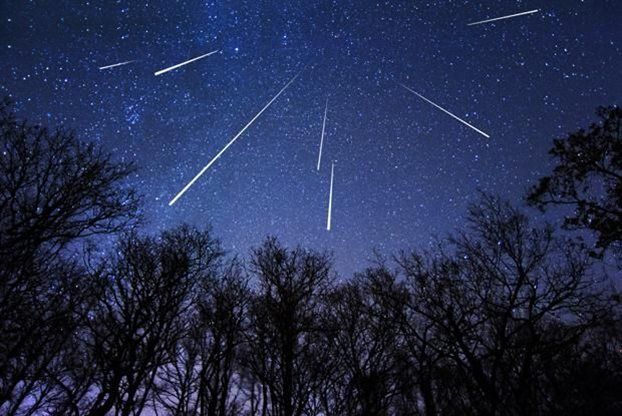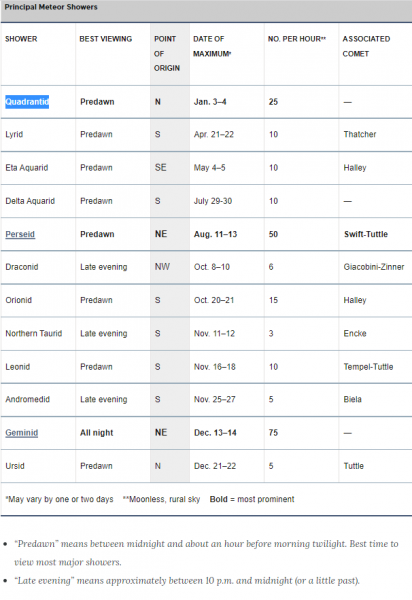
The new astronomical year begins, as every year, with a shower of passing stars, the Quadrantids, which this year will peak in Greece and the rest of the northern hemisphere this evening. But this year’s Quadrantids may be “overshadowed” by the fact that in a few days, on the evening of Friday 6 January, there will be a full moon – the first of 2023 – with the result that the sky will be quite bright and therefore only the brightest meteors will be possible to observe.
The Quadrantids, which usually last from January 1st to 5th, peaking in between, are best seen in more northern latitudes. At their peak, up to 40 meteors per hour enter Earth’s atmosphere at over 40 kilometers per second, and up to 120 meteors have been reported in some years. It is a better-than-average meteor shower, although it is less well-known than others such as the Leonids, Orionids and Geminids, as its meteors are fainter, but often light up the sky with unusually large “tails”.
This particular shower of “shooting stars” is named after a faint constellation (Quadrans Muralis – named after an ancient astronomical tool used before the invention of the telescope) discovered by the French astronomer Jerome Lalande in 1795, but does not exist any longer. Today the source of the meteors appears to be the constellation Boötes. In 1922, the International Astronomical Union (IAU) devised a list of 88 modern constellations. The list was agreed upon by the IAU at its inaugural general assembly held in Rome in May 1922.. It did not include a constellation Quadrans Muralis.
Astronomers aren’t yet sure what the passing comet was, which left behind a trail of dust and particles that turn into meteors every time they cross Earth’s orbit. It is likely to be the asteroid 2003 EH1, about three kilometers in diameter, which is a remnant of a former comet, C/1490 Y1. The asteroid in question was officially discovered in 2003, but the parent comet was first observed by Chinese, Japanese and Korean astronomers as early as the 15th century. The first observations of the passing Quadrantids in Europe were made by the Brussels Observatory in 1825.
The next major rainstorm will be the Lyrids which will peak on the 22nd and 23rd of April. 
Latest News

New Exposé by Domumento Reveals Nefarious Triangular Link of ‘Black Money’ with New Democracy, Blue Skies, & Truth Team
The latest exposé by the Documentonews.gr news site lays bare what appears to be a surreptitious path of indirect financing of ND through the business sector—transactions that, as widely understood, rarely occur without expectations of reciprocal benefit

PM Meloni Meets Vice President Vance in Rome Signalling Optimism on Ukraine Talks
Meloni emphasized the strength and strategic value of the Italy-U.S. partnership.

Airbnb: Greece’s Short-Term Rentals Dip in March Amid Easter Shift
Data from analytics firm AirDNA shows that average occupancy for short-term rentals dropped to 45% in March, down from 49% the same month last year.

Easter Week in Greece: Holy Friday in Orthodoxy Today
At the Vespers service on Friday evening the image of Christ is removed from the Cross and wrapped in a white cloth

Meloni and Trump Meet in Washington, Vow to Strengthen Western Ties
“I am 100% sure there will be no problems reaching a deal on tariffs with the EU—none whatsoever,” Trump stressed.

ECB Cuts Interest Rates by 25 Basis Points in Expected Move
The ECB’s Governing Council opted to lower the deposit facility rate—the benchmark for signaling monetary policy direction—citing an updated assessment of inflation prospects, the dynamics of underlying inflation, and the strength of monetary policy transmission.

Current Account Deficit Fell by €573.2ml Feb. 2025: BoG
The improvement of Greece’s current account was mainly attributed to a more robust balance of goods and, to a lesser extent, an improved primary income account

Hellenic Food Authority Issues Food Safety Tips for Easter
Food safety tips on how to make sure your lamb has been properly inspected and your eggs stay fresh.

Greek Kiwifruit Exports Smash 200,000-Ton Mark, Setting New Record
According to data by the Association of Greek Fruit, Vegetable and Juice Exporters, Incofruit Hellas, between September 1, 2024, and April 17, 2025, kiwifruit exports increased by 14.2%.

Easter Tourism Boom: Greece Sees 18.3% Surge in Hotel Bookings
Among foreign markets, Israel has emerged as the biggest growth driver, with hotel bookings more than doubling—up 178.5% year-on-year.







![Πλημμύρες: Σημειώθηκαν σε επίπεδα ρεκόρ στην Ευρώπη το 2024 [γράφημα]](https://www.ot.gr/wp-content/uploads/2025/04/FLOOD_HUNGRY-90x90.jpg)





![Airbnb: Πτωτικά κινήθηκε η ζήτηση τον Μάρτιο – Τι δείχνουν τα στοιχεία [γράφημα]](https://www.ot.gr/wp-content/uploads/2024/07/airbnb-gba8e58468_1280-1-90x90.jpg)


























 Αριθμός Πιστοποίησης
Αριθμός Πιστοποίησης